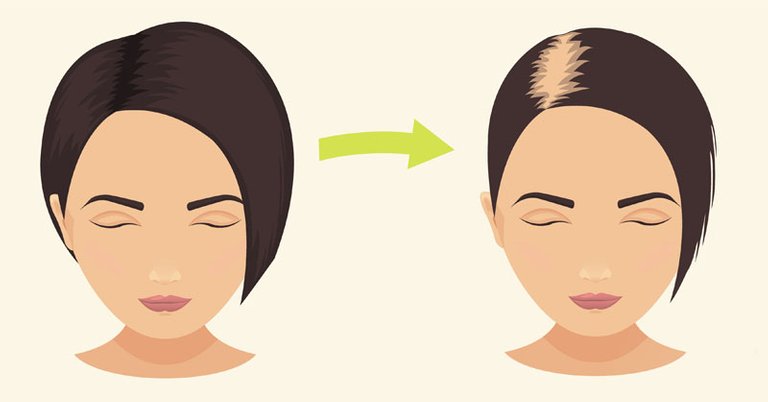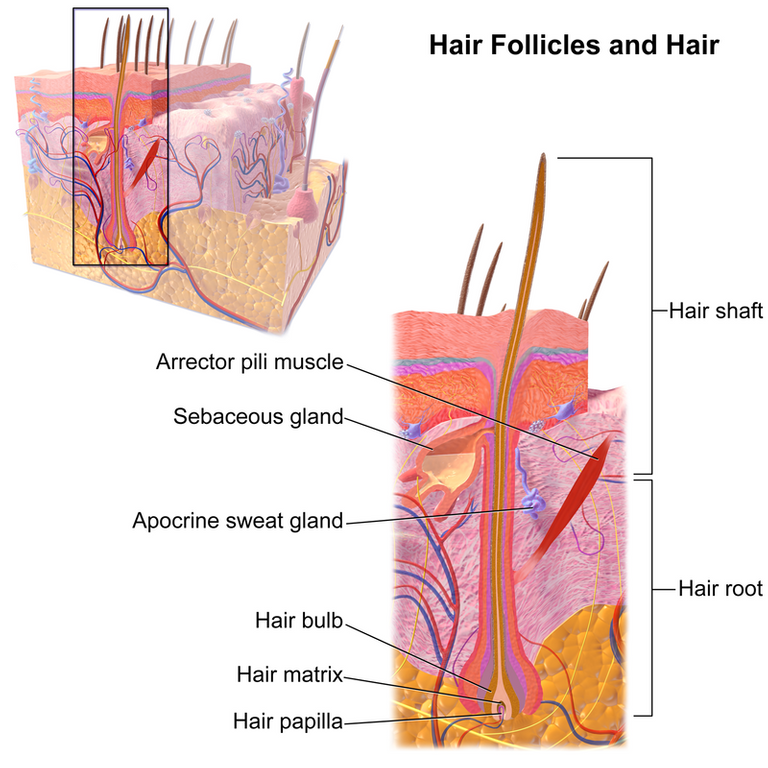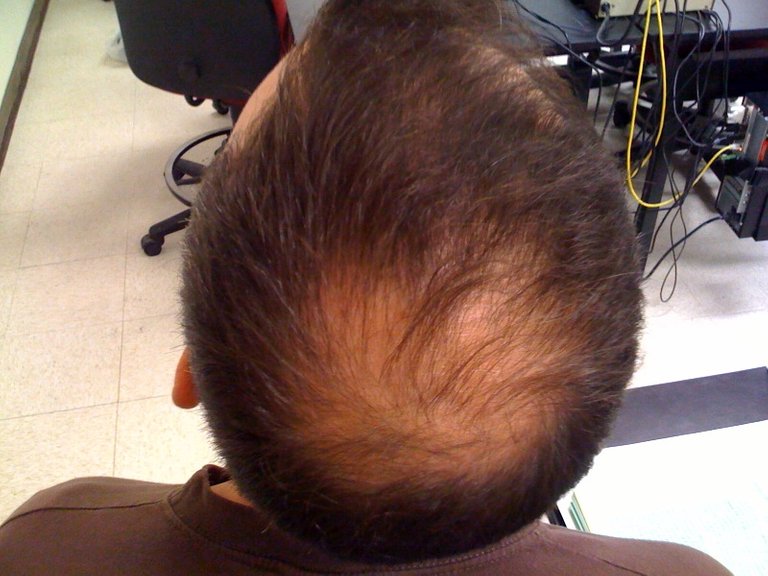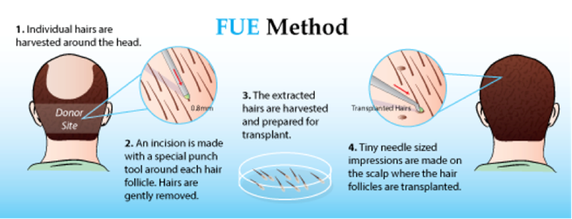Hey there welcome to my new article!
Baldness has been one of the major problems for males and females. According to a study, males are more affected. Believe it or not, everyone in their lifetime, experience hair loss, very mild to severe. If we look back through our history, most of the creative people have been bald. Most of the males, start losing their hair after hitting puberty, but it's might not be noticeable. "Alopecia" is the term used for baldness when it becomes visibly noticeable.

Image by Nhtindia, Wikimedia, CC BY-SA 4.0
Females mostly experience, thinning of the hair from the middle of the scalp rather than true hair loss. While they have the advantage of camouflaging this with their long hair, males aren't that lucky. So, what's the reason behind this phenomenon, and it this treatable? well, to understand that, we need to understand the anatomy of a hair follicle and phases of hair growth.
How does hair grow? (Life-cycle of a hair)
A normal, person might have 100,000 to 200,000 hairs on their scalp. But, it takes a lot of time, to reach this stage. It's a fact that we shed hair almost every day. Approx, 50-100 hairs are shed every day. If that continues, then it's only matter of a few months till you go completely bald, but that not the case. Therefore, it should be no surprise that hair has its own lifecycle. Believe me losing, 50-100 hair per day is completely fine until your hair is regrowing. The problem starts when there is an imbalance between regrow and loss of hair.
The hair growth cycles have four phases:
- Anagen
- Catagen
- Telogen
- Exogen
Anagen: This is the starting phase and the phase in which the hair actually grows. Therefore, this phase is also termed as the "growth phase", lasting for about 4-8 years. 90% percent of your hair is in this phase and might be growing at a rate of 1 cm per month.
Catagen: This phase begins when the anagen phase ends. This is a period, when the follicles, actually detach themselves from the blood-vessels. This deprives the follicles of nutrients and oxygen, which leads to its regression, and the growth stops. This almost lasts for 2-3 weeks. But why does this happen? Well, its believed this phase acts as a catalyst for the next phase.
Telogen: This is the phase when a hair strand detaches itself and falls out. This is completely normal and called a resting phase. The hair follicle in this phase remains inactive for approx 8-13 weeks. Keep in mind that, not all hair follicles follow the same timeline, if that was the case, we would lose all hair at once. Each follicle is different and independent and has got its own timeline. At, a particular given time only a few thousand hair follicles are in this phase, which leads to shedding of 50-100 hair daily. Hair loss only starts when this growth cycle is somehow imbalanced.
Exogen: This phase is just an extension of telogen where the shedding of the hair and growth of new hair occurs simultaneously. We can think of a period as the start of a new anagen period.
This is how a normal hair grows and sheds.
Normal anatomy of the Hair follicle
The anatomy of the hair is quite simple. A simple scalp hair can be divided into three regions.
- Lower segment
- middle segment
- upper segment
The lower segment consists of the true follicle and extends from the base of the follicle to the arrector pili muscle's attachment. The middle segment which is also known as "isthmus" is a short segment and extends from arrector pili muscle's attachment to the entrance of the sebaceous gland. The upper segment is what we see through our naked eyes. It extends from the sebaceous gland to the outside world.

Anatomy of hair by BruceBlaus, Wikimedia, CC BY-SA 3.0
The hair is made out of a hard structure protein "keratin". Keratin is just a collection of dead cells that is pushed upwards when new cells grow beneath it. At the base of the follicle, we find hair bulbs where the main cell division happens. Here cells divide continuously, to grow a hair shaft. Nourishment is provided by the blood vessels underneath the hair bulb. The growing hair shaft remains soft when it inside the skin and hardens after being pushed out of the skin due to the formation of keratin. The dermal papilla is the part of hair inside the hair bulb, which primary function is to regulate, hair cycle and also contains androgen receptors sensitive to DHT or dihydrotestosterone.
So, Why does the baldness occur?
According to a study, more than 90% of baldness in males is of type "male pattern baldness". There can be various reasons for baldness, stress, emotional factors, trauma, chemotherapy, surgery, and many more but all of these are just secondary factors. we will focus on two main reasons that lead to hair loss. hormones and genetics to be specific. Yes, most of the hair loss is because of genetics and is inherited.
Genetic cause: You might have heard people saying, if your parents are bald then you will go bald too but how much of that is true?. It's interesting to see, most of the hair loss genes come from your mother, not the father. how? you ask?. Well, this topic is still being researched by scientists but, until now, we have got some answers.

Hair loss by Welshsk, Wikimedia CC BY SA 3.0
As we all know, we have 46 chromosomes. Out of these 46 chromosomes, X and Y chromosome determines your sex. Girls have XX chromosomes whereas males have XY chromosomes. Scientists found out that the most important hair loss gene is located only in the X chromosome.
If you are a male, then you have X from mother and Y from father. IF the X chromosome that you inherited from your mother has hair loss genes then you have a 50% chance of experiencing hair loss. Therefore, for males, hair loss is inherited from the maternal side. It can be different for female baldness though.
If you are a female, you have two X chromosomes, one from your mother and one from your father. If your one X chromosome has a hair loss gene then the other one can help to hide the effects. Therefore, both the X chromosomes must-have hair loss genes to physically notice it.
Hormonal cause: Hormones affect the growth of your hair, more specifically, testosterone. Dihydrotestosterone is one of the products of testosterone. when there is excess DHT in the body, hair loss starts. We still are not clear about this phenomenon but some scientist suggests that DHT makes hair follicles start to shrink in mass by affecting the dermal papilla. The Dermal papilla is the part of the hair follicle which is sensitive to DHT As the follicle shrinks, the hair gets thinner. when the limit is reached, the follicle dies and stops producing hair.
Females produce testosterone too but, the levels are very less than males. Moreover, estrogen is always present to mask the effects of testosterone. Therefore, females experience a lot less hair loss than males.
Is there any cure for this?
Scientists are still trying to understand the complex chemical language of the body. Just like the heart and liver, a hair follicle is also a complex mini-organ. It has its own biological clock and functions independently. This organ-like other is created in the early stages of life. Therefore, it can't be regrown.
You can literally find thousands of products in the market that claim to regrow hair. But here is no evidence to back their claims whatsoever.
There are some FDA approved drugs that can surely slow down or might stop the process of hair fall but they have their own consequences.
Minoxidil: This is an over the counter drug and don't need a prescription. But I would recommend not using it if you don't know the consequences. This drug when used topically on the scalp dilates the blood supply of the follicle. The main drawback of this drug is, its not that effective as it is advertised. Takes a very long time, to notice and growth or of the hair, approx 6 months only if you apply it for 2-3 times. Most of the men get frustrated and demotivated after a month of use. Also, once stopped using, the condition can get a lot worse than it was before using it. So, only use it if recommended by your doctor.
Finasteride: This is probably more effective to slow down hair loss, but is a prescription drug and has some side effects too. Finasteride blocks the action of an enzyme named "5-alpha reductase". This enzyme converts testosterone to DHT. Therefore, less DHT leads to less hair fall. Benefits are noticed after a few months. Some rare side effects can be seen as a loss of sex drive and some sexual functions. Also, this drug increases the risk of prostate cancer in males.
Is hair transplant effective and how is it done?
Obviously, hair transplant is more effective today than it was a few years ago and definitely, it is more effective than those drugs. But it comes with a huge price tag. Just one session can range between $5000 - $15000. That's a lot but transplanted hair regrows(up to 80% of it). How does it work?
Simply, take it this way, a surgeon takes hair from one area of your body and transplants it on the part where it is needed. Typically, it's taken from the back part of the scalp but can be also taken from other parts of the body. There are two methods to perform this surgery.
- Follicular unit transplantation (FUT)
- Follicular unit extraction(FUE)
Follicular unit transplantation (FUT): This is a complex process. A surgeon basically, takes out a strip of scalp skin, approx 10 inches long from ear to ear. Then, the strip of the scalp is separated into minute pieces. One-piece might contain just one hair follicle. Minute holes are made in the area where it needs to be transplanted. Finally, a surgeon grafts the follicles into those minute holes. The number of grafts can depend on the type of hair and the amount of hair loss.
Follicular Unit Extraction(FUE): Every process is the same as FUT, the only difference is each follicle is directly plugged out one by one and grafted on the other area. No strip of scalp is taken out in this process.

FUE method by mcanhealth, Wikimedia CC BY-SA 4.0
Is stress and hair loss related?
Yes, to some extent they are related. But most of the stress-related hair loss is reversible. Mostly these are the types of hair loss due to stress:
- Telogen effluvium: This is the most common type of hair loss related to stress. As I explained above, the telogen phase of the growth cycle of hair. Telogen is the resting phase of a follicle when the shedding starts to grow new hair. While in stress, this telogen phase can be overactive, and a large number of follicles are pushed in this phase, resulting in too much shedding of hair. Just by washing your hair or combing, you can see a visible loss.
- Trichotillomania: This is a little bit psychological. While in too much stress, some people have the urge to pull out hair from the scalp in anger. Which results in damaged and weak follicles. This can be to deal with anger or negative things.
Hair loss due to both of these is reversible. As soon as you stop taking stress, you will notice visible thicking and of hair within a few weeks. Just be stress-free and prevent hair loss.
That's it for this article guys. I hope you learned something new today.
*All the images used are copyright free and are cited with appropriate credits*
References:
[1]https://en.wikipedia.org/wiki/Hair_loss [2]https://en.wikipedia.org/wiki/Management_of_hair_loss [3]https://www.intechopen.com/books/hair-and-scalp-disorders/anatomy-and-physiology-of-hair [4]https://nyhairloss.com/anatomy-hair/ [5]https://www.mayoclinic.org/healthy-lifestyle/stress-management/expert-answers/stress-and-hair-loss/faq-20057820 [6]https://www.healthline.com/health/does-hair-transplant-work
My other articles that you might like:
[1]What hallucinations tells us about our brain?
[2]An Obstructive Lung Disease - Asthma | All you need to know
On the contrary, if a male should inherit an affected X chromosome from his mother, he is sure to have the pattern baldness. The chance is 100% and not 50%.
For X-linked traits, males only need just one allele for the trait in order to exhibit the trait. This is because males have only one X chromosome. Females will need 2 alleles, each one the two X chromosomes in order to be affected. This is why males are more affected by X-linked disorders than females.
I should have said, the probability of inheriting the affected gene from the mother is 50%.
Thank you for pointing out this error. I Appreciate it.
Congratulations @idoctor! You have completed the following achievement on the Hive blockchain and have been rewarded with new badge(s) :
You can view your badges on your board And compare to others on the Ranking
If you no longer want to receive notifications, reply to this comment with the word
STOPSupport the HiveBuzz project. Vote for our proposal!
@tipu curate
Upvoted 👌 (Mana: 32/40)
!discovery 35
This post was shared and voted inside the discord by the curators team of discovery-it
Join our community! hive-193212
Discovery-it is also a Witness, vote for us here
Thanks for your contribution to the STEMsocial community. Feel free to join us on discord to get to know the rest of us!
Please consider supporting our funding proposal, approving our witness (@stem.witness) or delegating to the @stemsocial account (for some ROI).
Thanks for using the STEMsocial app and including @stemsocial as a beneficiary, which give you stronger support.